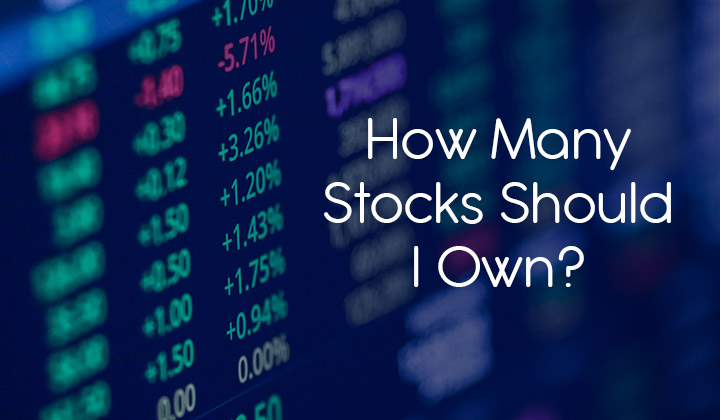How many stocks should I own? This is a common question many investors ask themselves. Unfortunately, no set number fits every situation or set of circumstances.
Market conditions, what you're investing for, and when you want to accomplish it are all pertinent factors. How much time you spend keeping up with market news and monitoring your holdings also matters. While there's no set number, several good guidelines exist that you can read about.

How Many Stocks Should I Own? – Diversification Is Key
Investing in stocks isn't the path to quick riches. You do it because you have long-term goals. Economic growth and compound interest fuel the rise in your assets and wealth. You have to diversify to make the most of good returns over time.Properly diversifying your portfolio minimizes how much exposure you have to what's called unsystematic risk. That kind of risk happens with certain industries or even individual companies. Spreading your risk across multiple companies or industries means that your portfolio should have far more growth than losses. That means you need enough different stocks to avoid letting one bad business or sector take you down with them.
Proper Portfolio Diversification
Investors are unable to diversify away systematic risk, such as the risk of an economic recession dragging down the entire stock market.
However, academic research in the area of modern portfolio theory has shown that a well-diversified equity portfolio can effectively reduce unsystematic risk to near-zero levels, while still maintaining the same expected return level a portfolio with excess risk would have.
When asking "how many stocks should I own?" – A minimum portfolio should have at least 10 different stocks in it. However, those stocks should not be in the same sector or industry. Diversification isn't just how many stocks you own but where they get spread out.
The Best Free Investment You’ll Ever Make
Join Wealth Daily today for FREE. We’ll keep you on top of all the hottest investment ideas before they
hit Wall Street. Become a member today, and get our latest free report: “Why You Need to Fire Your Money
Manager.”
It contains full details on why money managers are overpaid and provides you with
tools for growing your wealth.On your own terms. No fees, no commission.
Risks of Over-Diversification
While the minimum number of stocks you should own hovers around 10, you must also consider the maximum. Twenty to 30 might be a useful upper cap to your portfolio. While diversification has benefits, too much diversification carries risks.Owning too many stocks might wind up concentrating your portfolio in certain areas. This risk grows if you invest in mutual funds instead of individual stocks because there might be overlap. However, it can happen even with just securities themselves.
Another risk of over-diversification is mirroring an index, whether the Dow Jones or the NASDAQ. When your portfolio starts looking like an index fund, your returns will, too. Your chances of generating returns better than index funds go down.
How Many Stocks Should I Own? – Don't Drown Out Your Winners
Investing in too many stocks can also eat up your money. Taxes and transaction costs can nickel and dime your portfolio to death over time. Your time and mental energy are also at risk. Too many stocks can be too much to track with proper attention levels.
Sectors You Should Invest In
Proper stock selection involves lots of market research and analysis, either on your own or with a financial advisor. However, you need to ensure your 10 or more stocks get spread out across enough different investment sectors. The following list includes 10 different options for your consideration.
Basic Materials
This might prove one of the better long-term investments. The market for global construction materials has a 2030 forecast of $1.7 billion and nearly 4% compound annual growth every year until then. Low inventories and high demand for certain commodities help fuel growth in this sector.
Communication Services
Looking for another long-term investment? This sector proves worth a look. The global telecommunication services market might grow an average of 5.1% annually between now and 2031. URGENT: Look at This Map of America… There’s a silent invasion happening. Those black dots you see are electric vehicle charging stations — but they’re not like any chargers you’ve seen before. Because every one of those units could soon be putting money directly into your bank account… Twenty-four hours a day, seven days a week. Click here to discover what may be the biggest income opportunity of your lifetime.
Consumer Cyclical
Two factors determine consumer cyclical stocks. First, leisure, luxury, and durable goods usually fall into this category. Second, these stocks rely greatly on economic conditions and business cycles. Specific examples include the retail, entertainment, housing, and automotive industries.
Consumer Defensive Stocks
If you're not sure what this kind of stock is, think about Walmart. Consumer defensive stocks usually include companies that sell household goods, food, beverages, tobacco, packaging, and personal products. These stocks often provide steady dividend income, reflecting goods and services consumers spend money in even in a recession.
Energy
This sector also has a great long-term future. Oil and gas should grow between 4% and 5% annually in the coming years. Specific regions you should target include North Africa, the Americas, and the Middle East.
Financial Services
At the time of writing, this sector clocks a global value of $25 trillion, but it should double that by the end of the decade. A projected annual compound growth rate of nearly 10% entices many investors, and many stocks in this sector pay out strong dividends regularly. That helps your portfolio grow itself on top of increasing share values.
Healthcare
The current health and wellness market around the world holds a value of approximately $5 billion. The 2031 projection registers at just under $13 billion, with a projected growth rate of nearly 11% annually until then. That makes for a truly healthy long-term investment.
Industrials
Many national economies have entered post-industrial phases, but industrials still prove crucial to keeping physical goods seeing manufacture and distribution. From transportation to construction, heavy equipment remains a global necessity. As more industries move away from manual labor, including agriculture, this sector has a bright future.
Real Estate
The population might grow, but the amount of land available remains the same. The global real estate market had a 2021 value of $3.7 trillion. By 2030, it might double that.
Technology
You might think you missed several technology booms already, but this sector has plenty of growth potential left. Current global market value hovers around $8 billion, but an annual projected growth rate of 8% should grow this sector to $12 billion by 2027. Growth potential abounds both domestically and internationally.
How Many Stocks Should I Own? – Rebalancing Your Portfolio
Starting your portfolio proves necessary to get your investments going, but you must also rebalance it at various points to keep it healthy. One way to do it is rebalancing on a calendar-based basis. Some investors do this annually, and others do it quarterly.However, you can also rebalance based on specific triggers. This might happen when your portfolio winds up drifting past limits you determined in advance. A common boundary investors set could be a particular asset class changing by more than 10% of the desired target allocation.
How Many Stocks Should I Own at a Minimum?
There are many pieces of information and ideas to digest here. Much of it is useful in determining the proper number of stocks to put in your portfolio. At a minimum, you should have at least 10 different stocks for proper diversification. That stabilizes your portfolio, manages your risk, and helps you make the most of the growth opportunities you can access.How many stocks should I own? For more answers to questions like this, sign up for our free Wealth Daily newsletter today.


